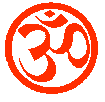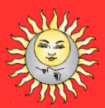

The Tantrik Gayatri
The soul is perfect; what can you improve? You have everything; what is there to gratify? Aum will seek out the man of contemplation; Reveal to him the wonder of great secrets - The Book of Ashes, Dadaji
The vedika form of the famous Gayatri mantra is: Om bhur-bhuvah-svah tat savitur varenyam bhargo devasya dhimahi dhiyo yo nah pracodayat. This can be translated: Om. Let us contemplate the spirit of the divine of the earth, the atmosphere and heaven. May that direct our minds. Savitri is the Sun and this mantra is pronounced at the three junctions or twilights of the day. Only the twice-born Brahmins are supposed to utter it.
The tantrik compilation Prapanchasaratantra, outlines pujas and meditations on Gayatri in chapter 20. Here is described how the mantra Om hums in the base or Muladhara chakra, and moves through seven stages to the chakra above the head. (Sahasrara).
According to Sir John Woodroffe, in his introduction to the Sanskrit edition, Mahavishnu describes Om as consisting of the following. Bhuh is existence, Bhuva is the elements, Svah is the atma of everything, Maha is greatness and light, Tat is Brahman (the absolute), Tapah is all knowledge, Satyam is supremacy and internal wisdom. This tantra connects the three letters of Om (A+U+M) to the seven worlds. (See also Jnanasankalini Tantra).
Tat, says Woodroffe, refers to the first cause of all substance, as fire in the circle of the sun and is supreme Brahman. Savituh is the source of all living beings. Varenyam is the excellent one who receives adoration. Bharga destroys sin, Devasya means it is full of light, while Dhimahi refers to knowledge being golden and always within the sun. Dhiyo means Buddhi, Yo stands for energy (tejas). The mantra is divided into three sections of eight letters and four sections of six letters. A dhyana (meditation) in the same chapter describes Gayatri as having four faces, which are white, yellow, red and black.
Yet the tantrik tradition has different views of the Gayatri. For example, in the Matrikabhedatantra, there is a couplet which says a person who knows the Brahman (the absolute), is a brahmin.
In the tantrik tradition, each aspect of devata has her or his own form of the Gayatri and it is often pronounced at the four junctions of the day, including midnight.
For example, Tripurasundari Gayatri runs: Tripurasundari vidmahe, kameshvari dhimahi, tanno klinne pracodayat. This means: Let us contemplate Tripurasundari, let us think of Kameshvari, may that wetness direct.
The Gandharva Tantra uses the 24 different syllables of this mantra in Sanskrit as a visualisation, starting from the base of the spine and moving to the top of the head.
The other tantrik Gayatri is a mantra known as Ajapa. This is recited by every living being unconsciously 21,600 times a day as she or he breathes. Half are sun breaths and half are moon breaths. It consists of the letters Ha and Sa.
Artwork is © Jan Bailey, 1996-2006. Translations are © Mike Magee 1996-2006. Questions or comments to mike.magee@btinternet.com
Back to the Home Page.